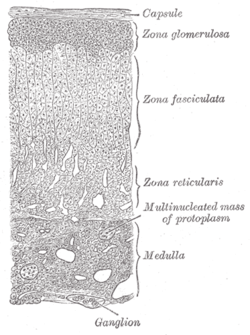Chromaffin cells
| Medullary chromaffin cell | |
|---|---|

Adrenal gland. (Medulla labeled at bottom right.)
|
|
| Details | |
| Identifiers | |
| Latin | endocrinocytus medullaris |
| Code | TH H3.08.02.6.00015 |
|
Anatomical terminology
[]
|
|
Chromaffin cells, also pheochromocytes, are neuroendocrine cells found mostly in the medulla of the adrenal glands (located above the kidneys) in mammals. They are in close proximity to pre-synaptic sympathetic ganglia of the sympathetic nervous system, with which they communicate, and structurally they are similar to post-synaptic sympathetic neurons. In order to activate chromaffin cells, the splanchnic nerve of the sympathetic nervous system releases acetylcholine, which then binds to nicotinic acetylcholine receptors on the adrenal medulla. This causes release of catecholamines. The chromaffin cells release catecholamines: ~80% of Epinephrine (Adrenaline) and ~20% of Norepinephrine (Noradrenaline) into systemic circulation for systemic effects on multiple organs (similarly to secretory neurons of the hypothalamus), and can also send paracrine signals. Hence they are called neuroendocrine cells.
In the mammalian fetal development (fourth to fifth week in humans), neuroblast cells migrate from the neural crest to form the sympathetic chain and preaortic ganglia. The cells migrate a second time to the adrenal medulla. Chromaffin cells also settle near the sympathetic ganglia, vagus nerve, paraganglia, and carotid arteries. The largest extra-adrenal cluster of chromaffin cells in mammals is the organ of Zuckerkandl. In lower concentrations, extra-adrenal chromaffin cells also reside in the bladder wall, prostate, and behind the liver.
...
Wikipedia
